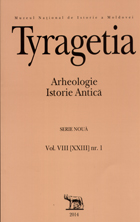Акинаки на западных рубежах Скифии. Находки скифских мечей и кинжалов с территории Республики Молдова
Akinakai on the western frontiers of Scythia. Scythian swords and daggers from the territory of the Republic of Moldova
Author(s): Denis A. TopalSubject(s): Archaeology
Published by: Muzeul Naţional de Istorie a Moldovei
Keywords: Scythian culture; Carpathian-Dniester region; akinakai
Summary/Abstract: Papers devoted to the typology of certain categories of the material culture need the close cooperation with the local schemes. A change of researching “optics” is likely to have a positive effect on the process of studying the general trends in the material, if this process of research is closely linked with the base of any typological constructions – with the spatial and chronological relations analysis. Besides the publication of new stray finds and partial republication of already known finds from the burial complexes, the main goal of this work is the checking of certain typological tendencies of such category of Scythian culture as akinakai (Scythian swords and daggers) of the Carpathian-Dniester region. A geographical division of Carpathian-Dniester region is proposed: Middle Dniester (Bukovinian) group, Eastern Carpathian (Neamţ) group, Siret-Dniester (Moldavian) group, Lower Dniester and Lower Danube groups. Chronologically, the massive of akinakai of Carpathian-Dniester region could be divided into three groups: Early Scythian (650-550 BC), Middle Scythian (550-450 BC) and Classic Scythian (450-300 BC). The following trends connected with Scythian swords and daggers were noticed: Early Scythian burials with akinakai concentrate in Bukovina and stray finds in Moldova, Middle Scythian burials – are grouping in Moldavian and the stray finds – in Neamţ group, and the Classical Scythian burials with akinakai are presented only in Lower Dnister and Lower Danube groups.
Journal: Tyragetia (Serie Nouă)
- Issue Year: VIII/2014
- Issue No: 1
- Page Range: 7-43
- Page Count: 37
- Language: Russian

